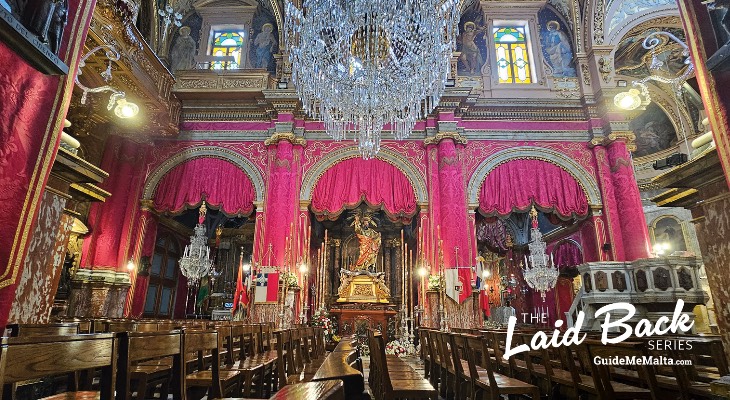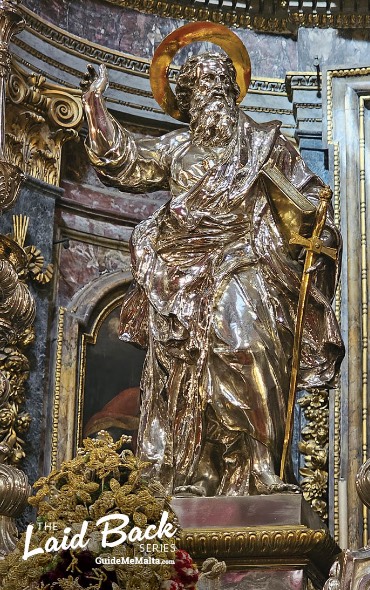Viva San Pawl! A glimmering tribute to tradition at St Paul's Shipwrecked Church in Valletta
The much-loved Collegiate Church shines in all its splendour, as the country prepares to celebrate the National Feast dedicated to St Paul’s Shipwreck on Malta in AD60.
Robert Cassar, 48, is busy polishing the huge solid silver lampier (oil lamp) which will adorn one of the side chapels at the St Paul Shipwrecked Church in Valletta, precisely the one dedicated to St Homobonus. His brother David is waiting for him in the church, as he finishes placing the intricate solid silver candlesticks on St Martin’s altar. The marble-clad walls of the Collegiate Church have turned bright red, as they are now sporting the ancient palm-frond damask, while the silverware is solidly on its way to find its place of honour. Festa time is here, and the air is electric with enthusiasm and joy.
“This is a very special time of year for us,” Robert tells me, as he connects another heavy silver oil lamp, to its apposite silver chain, ready to be hung in place. “Everything has its own place. Each chandelier, candlestick, statue or any other piece of decoration, goes in its appropriate place, reflecting an age-old tradition, that in turn tells a story of who that artefact was commissioned by, when and perhaps why.”
St Paul’s Church in Valletta boasts an enviable collection of opulent gear it sports this time of year, as it historically held a strategically favoured position in the country’s socio-economic landscape.
“For many years, this parish was arguably the gateway to Malta. What the Knights called Porta del Monte, or Victoria Gate for us today, right in the heart of the Pauline district, was the only entrance from the Grand Harbour, effectively making it the entrance to the country, much like what the airport would be today. That meant that the area was home to the country’s leading importers, merchants and traders, who in turn, as was custom, for many years showed their love to St Paul and his parish through their generous donations of silverware and art. This results in this extraordinary collection of artefacts that we are proud to curate and take care of year after year,” Robert explains.

Caring for these priceless articles comes as second nature to Robert, since by profession, he is a curator at the national heritage agency. Given his expertise on the subject matter, I take the opportunity to delve deeper into this stunning treasure throve.
“The silverware in the collection belongs to three distinct periods: The time of the Knights of St John until their departure in 1798 the early 19th century, and the late 19th century. These three periods showcase a difference in technique, provenance and, to a certain extent, trends of the times. For example, the older Knights of St John period silver is in its majority connected to some Knight or Grand Master who would have gifted it as a sign of devotion and respect to the revered church. One prime example is the main chandelier that hangs in the middle of the church at festa time, which was gifted personally by none other than Grand Master António Manoel de Vilhena. Same goes for all other artefacts, which have a rich and long history which sheds light on the love this community had for this church.”

Among the most treasured pieces in the Pauline Collegiate church, one can perhaps single out three star pieces. “The reliquary housing a piece of the wrist bone of the saint, which was crafted by Roman silversmith Vincenzo Belli and gifted to the Collegiate Chapter in the early 1800s, is a wonderful example of Baroque design and workmanship. The same can be said about the Chapter’s ceremonial mace, as well as a silver sculpture of the severed head of the saint, which sits atop a marble column with an incredible history.”
In fact, the story related to this last piece is quite extraordinary. It is well documented how the Canons of the Pauline Chapter continued to serve their community in the height of the plague of 1813–14, celebrating sacraments and seeing to the spiritual needs of their ailing parish. This dedication came at a price though, as three priests lost their lives to the deadly epidemic. This extraordinary display of Christian values reached the attention of His Holiness the Pope Pius VII, who decided to gift the church with a piece of the marble pillar on which St Paul was decapitated in AD67 – a most cherished relic indeed. The silver head, the fine work of another Roman silversmith, Filippo Pacetti, was crafted and added later, and now holds a place of prominence in the church.
Back to Robert, he tells me how the days leading to the feast are pretty intensive, but they pack an incredible sense of satisfaction.
“You can look at it as a burden, having to care for all this heritage, yet it is also a great privilege. When setting up the church, together with the scores of other volunteers, my favourite part is decorating the empty niche that houses the statue of St Paul throughout the year with an original display of gold and silver chalices, candlesticks, statues and all other beautiful pieces of art one can imagine. This changes from one year to the next, so it allows a great deal of creativity.”
“Historically, the emphasis was always on quality, commissioning the very best from the very best for the parishioner’s beloved church. This is reflected in everything the eyes rest on, from the titular statue of St Paul, crafted in Rome by Maltese genius sculptor Melchiorre Gafá, to the titular painting by Matteo Perez d’Aleccio which sits proudly at the back of the church, the music which is played during the High Mass by Maestro Paolo Nani and absolutely anything else. It is the way a community comes together to celebrate its beloved patron and show its devotion. We are privileged to form part of this long chain of love and dedication,” Robert concludes.
The feast of St Paul’s Shipwreck is a National Holiday in Malta and will be celebrated on Monday 10th February. For more information about the festivities, visit here.
This feature forms part of The Laid Back Series by GuideMeMalta.com. Bringing to light unique characters, local traditions, and the beauty of old Malta, we search every corner of the Maltese islands to find the most unique of stories that are sure to delight and bring a sense of nostalgia to our readers.
Do you have a fascinating story to tell? Drop us a line at [email protected]
